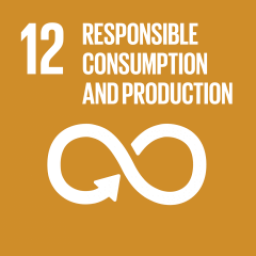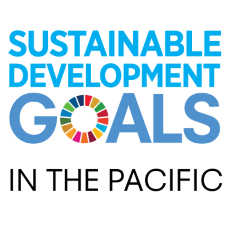
SDG 12 - Responsible Consumption and Production
Ensure sustainable consumption and production patterns
Inadequate waste management practices and restricted land availability are contributing to increased volumes of solid and hazardous wastes in the region.
Organic waste constitutes approximately 44 per cent of the waste stream, and over 80 percent of ocean litter is derived from land-based sources.
There is currently limited data on recycling rates and hazardous waste treatment in the Pacific, although these are identified as priorities for sustainable development.
Implement the 10-year framework of programmes on sustainable consumption and production, all countries taking action, with developed countries taking the lead, taking into account the development and capabilities of developing countries
Indicator 12.1.1: Number of countries developing, adopting or implementing policy instruments aimed at supporting the shift to sustainable consumption and production
NOTE: this indicator is not one of the 132 indicators in the Pacific SDG indicator subset
By 2030, achieve the sustainable management and efficient use of natural resources
Indicator 12.2.1: Material footprint, material footprint per capita, and material footprint per GDP
NOTE: this indicator is not one of the 132 indicators in the Pacific SDG indicator subset
Indicator 12.2.2: Domestic material consumption, domestic material consumption per capita, and domestic material consumption per GDP
NOTE: this indicator is not one of the 132 indicators in the Pacific SDG indicator subset
By 2030, halve per capita global food waste at the retail and consumer levels and reduce food losses along production and supply chains, including post-harvest losses
Indicator 12.3.1: (a) Food loss index and (b) food waste index
NOTE: this indicator is not one of the 132 indicators in the Pacific SDG indicator subset
By 2020, achieve the environmentally sound management of chemicals and all wastes throughout their life cycle, in accordance with agreed international frameworks, and significantly reduce their release to air, water and soil in order to minimize their adverse impacts on human health and the environment
Indicator 12.4.1: Number of parties to international multilateral environmental agreements on hazardous waste, and other chemicals that meet their commitments and obligations in transmitting information as required by each relevant agreement
| Pacific Island Countries and territories | Basel convention | Montreal convention | Rotterdam convention | Stockholm convention |
|---|---|---|---|---|
| Cook Islands | 20% | 100% | 96.55% | 25% |
| Fiji | 0% | 100% | 0% | 25% |
| Micronesia (Federated States of) | 20% | 100% | 0% | 25% |
| Kiribati | 20% | 100% | 0% | 87.5% |
| Marshall Islands | 20% | 100% | 8.62% | 25% |
| Nauru | 20% | 100% | 0% | 25% |
| Niue | 0% | 100% | 0% | 25% |
| Papua New Guinea | 20% | 100% | 33.3% | 25% |
| Palau | 20% | 100% | 0% | 12.5% |
| Solomon Islands | 0% | 100% | 0% | 0% |
| Tonga | 20% | 100% | 62.07% | 25% |
| Tuvalu | 0% | 100% | 0% | 12.5% |
| Vanuatu | 20% | 100% | 41.38% | 75% |
| Samoa | 40% | 100% | 70.69% | 25% |
![]() Download Metadata for indicator 12.4.1
Download Metadata for indicator 12.4.1
Indicator 12.4.2: (a) Hazardous waste generated per capita; and (b) proportion of hazardous waste treated, by type of treatment
Visualisation(s) not yet available
View data for indicator 12.4.2 on PDH.stat
By 2030, substantially reduce waste generation through prevention, reduction, recycling and reuse
Indicator 12.5.1: National recycling rate, tons of material recycled
Visualisation(s) not yet available
View data for indicator 12.5.1 on PDH.stat
Encourage companies, especially large and transnational companies, to adopt sustainable practices and to integrate sustainability information into their reporting cycle
Indicator 12.6.1: Number of companies publishing sustainability reports
NOTE: this indicator is not one of the 132 indicators in the Pacific SDG indicator subset
Promote public procurement practices that are sustainable, in accordance with national policies and priorities
Indicator 12.7.1: Degree of sustainable public procurement policies and action plan implementation
NOTE: this indicator is not one of the 132 indicators in the Pacific SDG indicator subset
By 2030, ensure that people everywhere have the relevant information and awareness for sustainable development and lifestyles in harmony with nature
Indicator 12.8.1: Extent to which (i) global citizenship education and (ii) education for sustainable development (including climate change education) are mainstreamed in (a) national education policies; (b) curricula; (c) teacher education; and (d) student assessment
NOTE: this indicator is not one of the 132 indicators in the Pacific SDG indicator subset
Support developing countries to strengthen their scientific and technological capacity to move towards more sustainable patterns of consumption and production
Indicator 12.a.1: Installed renewable energy-generating capacity in developing countries (in watts per capita)
NOTE: this indicator is not one of the 132 indicators in the Pacific SDG indicator subset
Develop and implement tools to monitor sustainable development impacts for sustainable tourism that creates jobs and promotes local culture and products
Indicator 12.b.1: Implementation of standard accounting tools to monitor the economic and environmental aspects of tourism sustainability
| Pacific Island Countries and territories | 12.b.1 Number of sustainable tourism strategies or policies | 12.b.1 Implementation of standard accounting tools to monitor the economic and environmental aspects of tourism (SEEA tables) | 12.b.1 Implementation of standard accounting tools to monitor the economic and environmental aspects of tourism (Tourism Satellite Account tables) | 12.b.1 Implementation of standard accounting tools to monitor the economic and environmental aspects of tourism (number of tables) |
|---|---|---|---|---|
| Fiji | 3 | 3 | 3 | 6 |
| French Polynesia | 0 | 0 | 0 | 0 |
| Guam | 0 | 0 | 3 | 3 |
| Kiribati | 0 | 0 | 0 | |
| Marshall Islands | 0 | 1 | 1 | |
| Micronesia (Federated States of) | 0 | 0 | 0 | 0 |
| New Caledonia | 0 | 0 | 0 | 0 |
| Palau | 2 | 0 | 2 | 2 |
| Samoa | 0 | 0 | 0 | 0 |
| Vanuatu | 0 | 0 | 0 | 0 |
Rationalize inefficient fossil-fuel subsidies that encourage wasteful consumption by removing market distortions, in accordance with national circumstances, including by restructuring taxation and phasing out those harmful subsidies, where they exist, to reflect their environmental impacts, taking fully into account the specific needs and conditions of developing countries and minimizing the possible adverse impacts on their development in a manner that protects the poor and the affected communities
Indicator 12.c.1: Amount of fossil-fuel subsidies per unit of GDP (production and consumption)
NOTE: this indicator is not one of the 132 indicators in the Pacific SDG indicator subset

